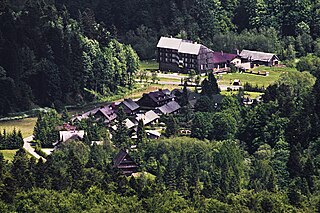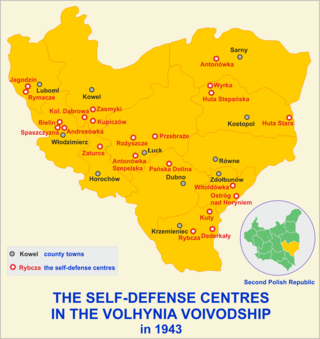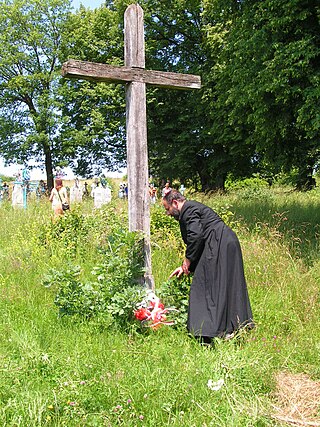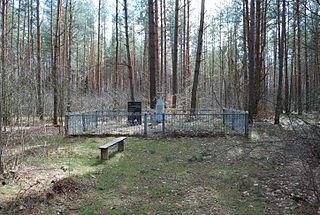
The Massacres of Poles in Volhynia and Eastern Galicia were carried out in German-occupied Poland by the Ukrainian Insurgent Army (UPA), with the support of parts of the local Ukrainian population, against the Polish minority in Volhynia, Eastern Galicia, parts of Polesia, and the Lublin region from 1943 to 1945.

Muczne is a village in southeastern Poland in Subcarpathian Voivodeship, Bieszczady County, Gmina Lutowiska, near the border with Ukraine, in the valley of the Muczny stream. It lies approximately 15 kilometres (9 mi) south of Lutowiska, 36 km (22 mi) south of Ustrzyki Dolne, and 114 km (71 mi) south-east of the regional capital Rzeszów.

The Janowa Dolina massacre took place on 23 April 1943 in the village of Janowa Dolina, during the occupation of Poland in World War II. Before the Nazi invasion of the Polish Second Republic, Janowa Dolina was a model settlement built in the Kostopol County of the Wołyń Voivodeship by workers of the Polish State Basalt Quarry. The town was inhabited by 2,500 people. Its name, which translates as the "Janow's Valley" in Polish, came from the Polish king Jan Kazimierz, who reportedly hunted in the Volhynian forests, and after hunting — rested on the shore of the Horyń (Horyn) River. The town was destroyed during World War II by the Ukrainian Insurgent Army who murdered most of its Polish population including women and children.

The Huta Pieniacka massacre was a mass murder of the Polish inhabitants of the village Huta Pieniacka, located in modern-day Ukraine, which took place on February 28, 1944. Estimates of the number of victims range from 500 to 600-800 to 1,200.

The Defence of Przebraże was fought between the Ukrainian Insurgent Army against the Polish Self–Defense, Home Army and Soviet partisans in the Łuck County of the Wołyń Voivodeship. The Northern Operational Group under the command of Dmytro Klyachkivsky and 3rd Operational Group "Turiv" under the command of Yuriy Stelmaschuk tried four times to destroy and conquer the largest Polish Self–Defense base and center in the Volhynia, but the UPA didn't succeed.
Dominopol is a defunct village located in the present-day area of Volodymyr-Volynskyi Raion of Volyn Oblast in Ukraine. On July 11, 1943, at the height of the Massacres of Poles in Volhynia, the village was attacked by a death squad of Ukrainian Insurgent Army aided by the Ukrainian peasants, and all ethnic Poles regardless of age and gender were tortured and murdered. Before World War II, Dominopol was a village in the Eastern regions of the Second Polish Republic, located in the Gmina Werba, Powiat Włodzimierz of the Wołyń Voivodeship. The area was invaded by the Soviet Union in 1939 and during Operation Barbarossa annexed by Nazi Germany into Reichskommissariat Ukraine in 1941.
Dovhyi Voinyliv is a village in Kalush Raion, Ivano-Frankivsk Oblast, Ukraine. Before World War II the village was part of Kałusz county in Stanisławów Voivodship, Second Republic of Poland. Dovhyi Voinyliv belongs to Verkhnia rural hromada, one of the hromadas of Ukraine.
The village of Adamy was burned to the ground during the Massacres of Poles in Volhynia and Eastern Galicia, and no longer exists. It was destroyed by the Ukrainian Insurgent Army aided by the Ukrainian peasants who set ablaze 200 Polish farms and murdered whomever they could find. Adamy was located in powiat Kamionka Strumiłowa (county) near Busk in the Tarnopol Voivodeship of the Second Polish Republic before the Nazi-Soviet invasion of Poland in 1939.

Stara Huta is a village in northwestern Ukraine, in Kovel Raion of Volyn Oblast, but was formerly administered within Stara Vyzhivka Raion. The population of the village is 1024 people.

The Korosciatyn massacre took place on the night of February 28/29, 1944, during the province-wide wave of massacres of Poles in Volhynia in World War II. Korosciatyn, which now bears the name of Krynica and is located in western Ukraine, was one of the biggest ethnic Polish villages of the interwar Poland's within Buczacz County in Tarnopol Voivodeship (pictured). Located along the railway line from Tarnopol to Stanislawów, in 1939 it had some 900 inhabitants, all of them being ethnic Poles.

The Podkamień massacre or the Pidkamin massacre of 12 March 1944 was the massacre of Polish civilians committed by the Ukrainian Insurgent Army (UPA) under the command of Maksym Skorupsky (Maks). The victims were ethnic Polish residents of Podkamień, Tarnopol Voivodeship. During the war the area was administratively part of the Nazi German Reichskommissariat Ukraine. Estimates of victims include 150, more than 250 and up to 1000.

The Palikrowy massacre was a war crime committed by 4th police SS-regiment made up of Ukrainian soldiers of the SS-Galizien who were removed from the SS-Galizien at the time of the massacre and placed under German police command, Ukrainian SVK forces and Ukrainian Insurgent Army on Poles in the village of Palikrowy, which took place on 12 March 1944. A total of 385 Poles were killed.

The Parośla I massacre was committed during World War II by the Ukrainian Insurgent Army (UPA) under the command of Hryhorij Perehijniak "Dowbeszka-Korobka" on 9 February 1943 against the ethnic Polish residents of the village of Parośla in the Nazi-controlled Reichskommissariat Ukraine. It is considered a prelude to the ethnic cleansing of Poles in the Volhynia region by the UPA, and is recognized as the first mass murder committed by the Ukrainian Insurgent Army in the area. Estimates of the number of victims range from 149 to 173.

The Baligród massacre occurred on Sunday, 6 August 1944 in Baligród, Lesko County, Poland. Ukrainian nationalists with the Ukrainian Insurgent Army (UPA) entered the village of Baligród and killed 42 members of the Polish community.
The Wiązownica massacre occurred on 17 April 1945 in the village Wiązownica, located in Jarosław County Subcarpathian Voivodeship, in southeastern Poland, then located in Lwów Voivodeship. It was one of the Massacres of Poles in Volhynia and Eastern Galicia, and was perpetrated by the Ukrainian Insurgent Army (UPA). The massacre occurred during a battle fought between the UPA and, initially, local Polish partisans, and, later, the Polish People's Army (LWP), towards the outskirts of Wiązownica. It saw the deaths of 91 civilians, including 20 women and children, alongside four LWP soldiers. The UPA also burned down 150 houses. In retaliation for the attack, the LWP led an attack on the village Piskorowice, given its large concentration of Ukrainians sympathetic for OUN.

Wiśniowiec massacres . In the monastery of Discalced Carmelites and in the city Wiśniowiec (Vyshnivets) in February 1944 an armed group of the OUN massacred 300 Poles who had sought refuge there. Most people were hiding in the monastery and in the abandoned Vyshnivets Palace. At the same time in the village Wiśniowiec Stary took place another massacre, where 138 Poles were killed by UPA.
Hurby massacre was a mass murder of the Polish population of the Hurby village, perpetrated on June 2, 1943, by a death squad of the Ukrainian Insurgent Army (UPA) and so-called brushwood self defence commando made up of Ukrainian peasants, during the province-wide Massacres of Poles in Volhynia and Eastern Galicia in World War II. Hurby belonged to the Second Polish Republic before the war began. It used to be located in the powiat Zdobłunowski of the Wołyń Voivodeship. It is now a valley by the same name in western Ukraine. About 250 Poles were murdered in the attack, which was confirmed by the UPA commander for Volyn, Dmytro Klyachkivsky, who said in his communique of June 1943 that Hurby "went up in smoke".
Gaj massacre was a massacre of the Polish population of Gaj, committed on 30 August 1943 by the Ukrainian Insurgent Army death squad aided by the Ukrainian peasants, in which 600 civilian Poles were killed, including a large number of children. The mass murder operation in Gaj was carried out during the province-wide Massacres of Poles in Volhynia and Eastern Galicia. The settlement founded in the 1920s was burned to the ground by OUN-UPA and no longer exists. When the Polish self-defence unit from nearby Rożyszcze arrived at the Gaj colony a few days later the bodies of victims were strewn everywhere. They identified and shot several Ukrainian collaborators and set their houses of fire in retaliation. The Gaj colony was located in the Kowel County of the Wołyń Voivodeship in the Second Polish Republic.

Budy Ossowskie massacre was a mass murder of ethnic Poles carried out on 29–30 August 1943 by a death squad of the Ukrainian Insurgent Army aided by the Ukrainian peasants during the Massacres of Poles in Volhynia and Eastern Galicia. About 290 people were killed, including women and children, all of them, Polish inhabitants of the Budy Ossowskie village, located in the Kowel County of the Wołyń Voivodeship in the Second Polish Republic. Budy Ossowskie village does not exist anymore. It was burned to the ground by the OUN-UPA. The charred remnants of the village were cleared in Soviet Ukraine for grazing cattle. Overall, in the Kowel County some 7,300 ethnic Poles were murdered.
Zagaje massacre was a mass murder of ethnic Poles carried out on 11–12 July 1943 by the troops of the Ukrainian Insurgent Army group "Piwnicz", aided by the Ukrainian peasants, during the Massacres of Poles in Volhynia and Eastern Galicia. Approximately 260–350 people were killed, including women and children. The village Zagaje was levelled out and does not exist anymore. It was located in the gmina Podberezie of the Horochów County in the Wołyń Voivodeship of the Second Polish Republic. Overall, in the Horochów County some 4,200 ethnic Poles were murdered, in nearly hundreds of separate locations before the end of the Polish-Ukrainian conflict. The village Zagaje is not to be confused with the Zagaje colony, located in gmina Czaruków, powiat Łuck, of the same voivodeship.












